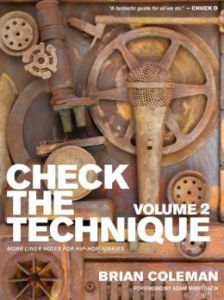
The final book in Brian Coleman’s trilogy is yet more essential reading
Coleman gives a background to some of the hip-hop classics you love, and shows greatness can be achieved by all

![]() n 2005, journalist Brian Coleman released a book that sought to address the absence of historical context in hip-hop. Entitled Rakim Told Me: Hip-Hop Wax Facts, Straight From The Original Artists, the 80s the text was a riposte to the absence of linear notes in many hip-hop albums and sought to tell the story of not just the creation of classic hip-hop albums, but also their songs; its art for storytelling being, as its title says, “straight from the original artists’s mouths”.
n 2005, journalist Brian Coleman released a book that sought to address the absence of historical context in hip-hop. Entitled Rakim Told Me: Hip-Hop Wax Facts, Straight From The Original Artists, the 80s the text was a riposte to the absence of linear notes in many hip-hop albums and sought to tell the story of not just the creation of classic hip-hop albums, but also their songs; its art for storytelling being, as its title says, “straight from the original artists’s mouths”.
Rakim… was not just infectious reading, but a must-have for anyone interested in hip-hop culture, and in 2007 Coleman expanded the text and released Check the Technique: Liner Notes for Hip-Hop Junkies. Check the Technique Volume 2: More Liner Notes for Hip-Hop Junkies once again creates the linear notes for a series of classic hip-hop albums, completing Coleman’s trilogy.
As with its predecessors, Volume 2… adopts a chronological approach that largely allows the interviewees to tell the story behind creating their album, with Coleman making additions where necessary to complete the narrative, and knitting together the gaps in-between the background and the artists’ explanations. The book covers 25 albums, including Mos Def & Talib Kweli’s Are Black Star, Jeru The Damaja’s The Sun Rises In The East, and Smif-N-Wessun’s Dah Shinin, and features interviews with artists ranging from DJ Jazzy Jeff to Ice Cube, with the history of each treated with the care of a professor and enthusiasm of a fan. The track-by-track dissections of the albums by their creators is a rewarding approach, and gives fans a chance to get the inside stories behind the composition of individual songs and learn how the songwriting process works – such as The Coup’s Me And Jesus The Pimp In A ’79 Granada Last Night’s original inspiration being of how sexism against women hurts men’s lives too.
One of the truly enchanting qualities of music books is the deconstruction of the deliberate, showing that great records are equally about chance; to appreciate that an artist is a genius is to be in awe, but to discover they’re human is inspiring. Like all great music interpreters, Coleman’s true strength lies is in his ability to let scratch away the impenetrable veneer that surrounds legends, while at the same time making their very normalcy a fable. Learning that Kool Keith’s genius creation Dr Octagon began from Keith “just fucking around” brings a human quality to the greatness that would spawn from it. Coleman shows too that drive is essential, with the ‘linear notes’ of artists such as Gravediggaz highlighting the drivers of success as being adversity, desire, sadness, anger, joy and creativity. The real strength of Volume 2… then is to show that being a great artist is not something distant and unachievable, but something that can be gripped; something human.
Check the Technique Volume 2: More Liner Notes for Hip-Hop Junkies is an exceptional book, one that all fans of hip-hop should own. More than that though, it’s a book for fans of all music, because it gives hope and shows that you just need to stay true to your belief in your ability. Its message is that even if the money doesn’t roll in, as long as you do it for the love you’ll experience success. As Jazzy Jeff says: “My biggest goal back then was to be able to one day tell my kids that I was on a record. Then I could get a job at the post office, and everything would be great. As long as I was on a record.”
Verdict: A book to be enjoyed by anyone with an interest in music
![]()
![]()
![]()
![]()
![]()
Damien Girling


































Related Articles